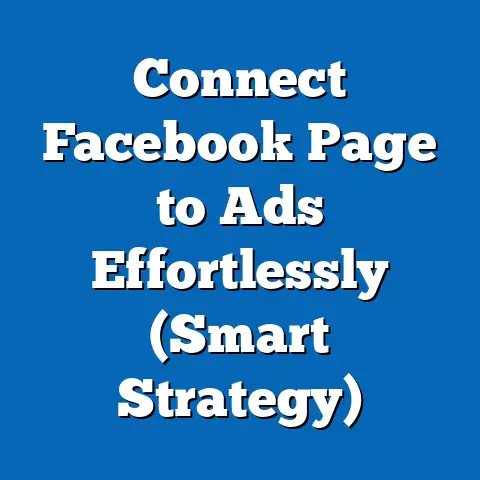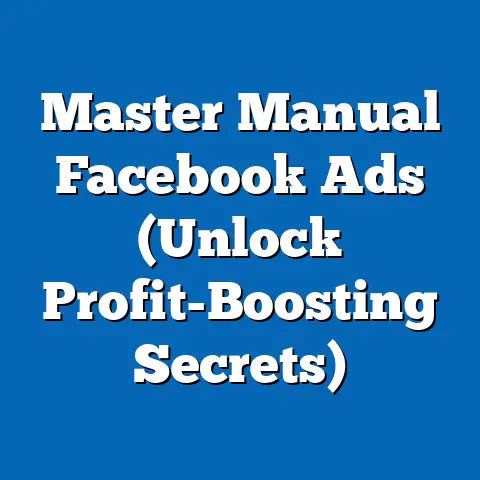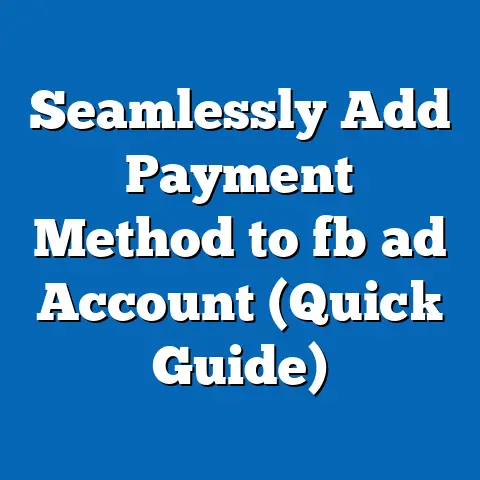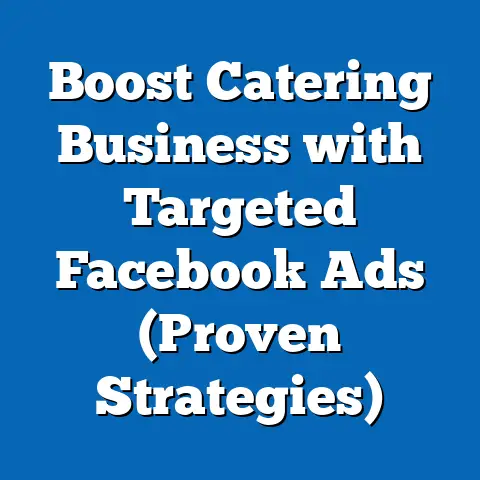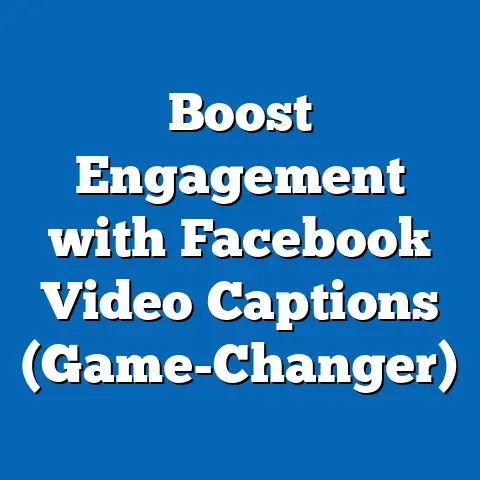Unlocking Facebook’s Best Ads of 2025 (Proven Strategies)
We often think of advertising as an expense, a necessary evil to get our products and services in front of potential customers. But what if I told you that Facebook advertising, done right, could be one of the highest-return investments you make in 2025? It’s a bold claim, I know, but consider this: Facebook boasts a massive user base, unparalleled targeting capabilities, and a constantly evolving platform designed to connect businesses with the right people. The potential is enormous.
However, the digital advertising landscape is in constant flux. What worked yesterday might not work today, and what works today might be obsolete tomorrow. To truly succeed with Facebook ads, you need to stay ahead of the curve, understand the latest trends, and implement proven strategies that cut through the noise and resonate with your target audience.
Think of it like investing in the stock market. You wouldn’t blindly throw money at any random stock, would you? You’d research, analyze market trends, and identify companies with strong potential for growth. Similarly, with Facebook ads, you need a strategic approach, a deep understanding of your audience, and a willingness to adapt and optimize your campaigns.
Section 1: The Evolution of Facebook Advertising
To understand the best strategies for 2025, it’s crucial to understand how Facebook advertising has evolved. I’ve been working with Facebook ads since almost the beginning, and I’ve seen firsthand the dramatic changes that have shaped the platform.
In the early days, Facebook advertising was relatively simple. Targeting was limited, ad formats were basic, and the focus was primarily on generating likes and shares. However, as Facebook’s user base grew and the platform matured, so did its advertising capabilities.
One of the biggest shifts came with the introduction of more sophisticated targeting options. Facebook began collecting vast amounts of data on its users, allowing advertisers to target audiences based on demographics, interests, behaviors, and even life events. This level of granularity opened up a whole new world of possibilities for reaching the right people with the right message.
Another significant development was the evolution of Facebook’s algorithm. Over the years, Facebook has made numerous changes to its algorithm, which determines which content users see in their newsfeeds. These changes have had a profound impact on advertising, as they have influenced ad visibility, reach, and engagement.
More recently, privacy regulations like GDPR and CCPA have forced Facebook to make changes to its data collection and targeting practices. This has led to a greater emphasis on transparency and user consent, and it has required advertisers to adapt their strategies to comply with these regulations.
Trends in 2025:
As we move into 2025, several key trends are shaping the landscape of Facebook advertising:
- Rise of Short-Form Video Ads: Short-form video content, popularized by platforms like TikTok and Instagram Reels, has become increasingly popular on Facebook. Advertisers are leveraging short-form video ads to capture attention quickly and deliver concise, engaging messages.
- Interactive Content: Interactive ad formats, such as polls, quizzes, and augmented reality experiences, are gaining traction. These formats encourage user engagement and provide a more immersive brand experience.
- AI-Powered Advertising: Artificial intelligence (AI) is playing an increasingly important role in Facebook advertising. AI-powered tools are being used to automate ad creation, optimize targeting, and personalize ad experiences.
- Focus on Authenticity: Consumers are becoming more discerning about the ads they see online. There’s a growing demand for authentic and transparent advertising that resonates with their values and interests.
Case Study: Early 2025 Success
Let’s look at a successful campaign from early 2025 to illustrate these changes. A local bakery, “Sweet Surrender,” wanted to promote their new line of vegan pastries. Instead of running generic ads, they leveraged short-form video content showcasing the creation process of their pastries. They targeted users interested in veganism, baking, and local food. The results were impressive: a 30% increase in website traffic and a 20% boost in sales of vegan pastries. This campaign highlights the power of short-form video, targeted advertising, and authentic content.
Key Takeaway: The evolution of Facebook advertising is a continuous process. To succeed in 2025, you need to stay informed about the latest trends, adapt to algorithm changes, and comply with privacy regulations.
Next Step: Research the latest Facebook advertising updates and features to stay ahead of the curve.
Section 2: Understanding Your Audience
I can’t stress this enough: understanding your audience is the most crucial investment you can make in your Facebook ad campaigns. Without a deep understanding of who you’re trying to reach, your ads are likely to fall flat. It’s like trying to sell snow to Eskimos – you’re wasting your time and money.
Facebook offers a wealth of tools and resources to help you understand your audience. One of the most valuable is Facebook Audience Insights. This tool provides detailed information about the demographics, interests, behaviors, and lifestyles of people on Facebook. You can use Audience Insights to:
- Identify your target audience’s age, gender, location, and education level.
- Discover their interests, hobbies, and activities.
- Learn about the pages they like, the groups they join, and the events they attend.
- Understand their purchasing habits and online behavior.
Creating Buyer Personas:
Once you’ve gathered data from Audience Insights and other sources, you can start creating buyer personas. A buyer persona is a fictional representation of your ideal customer. It’s based on research and data about your existing customers and potential customers.
A well-developed buyer persona should include:
- Demographic information: Age, gender, location, income, education, etc.
- Psychographic information: Values, interests, lifestyle, personality, etc.
- Goals and challenges: What are they trying to achieve? What are their biggest obstacles?
- Pain points: What frustrates them? What problems are they trying to solve?
- Buying behavior: How do they research products and services? What influences their purchasing decisions?
Gathering Data to Inform Personas:
To create accurate and insightful buyer personas, you need to gather data from various sources:
- Customer surveys: Ask your existing customers about their experiences, preferences, and challenges.
- Customer interviews: Conduct one-on-one interviews with your customers to gain a deeper understanding of their needs and motivations.
- Website analytics: Analyze your website traffic to identify patterns in user behavior.
- Social media analytics: Track your social media engagement to understand what content resonates with your audience.
- Sales data: Analyze your sales data to identify trends in customer purchases.
Segmenting Your Audience:
Once you’ve created your buyer personas, you can start segmenting your audience based on various criteria. Segmentation allows you to tailor your ads to specific groups of people, which can significantly improve their effectiveness.
Common segmentation criteria include:
- Demographics: Age, gender, location, income, education, etc.
- Interests: Hobbies, activities, passions, etc.
- Behaviors: Purchasing habits, online activity, etc.
- Life events: New job, marriage, birth of a child, etc.
Example of Successful Audience Identification:
A local fitness studio, “FitLife,” struggled to attract new members. After conducting thorough audience research, they discovered that their ideal customer was a busy professional aged 30-45 who was interested in health and wellness but struggled to find time for exercise. Based on this information, FitLife created targeted ads promoting their express workout classes and online fitness programs. They also offered a free trial for new members. As a result, FitLife saw a 40% increase in new membership sign-ups.
Key Takeaway: Understanding your audience is essential for creating effective Facebook ad campaigns. Use Facebook Audience Insights, create buyer personas, and segment your audience to tailor your ads to specific groups of people.
Next Step: Conduct audience research using Facebook Audience Insights and create buyer personas for your target audience.
Section 3: Crafting Compelling Ad Copy and Creative
Now that you understand your audience, it’s time to craft compelling ad copy and creative that resonates with them. This is where the art of advertising comes into play. It’s not just about writing a few words and slapping on a picture; it’s about understanding the psychological triggers that drive engagement and conversions.
Psychological Triggers:
Several psychological triggers can be used to make your ads more effective:
- Scarcity: Create a sense of urgency by highlighting limited-time offers or limited quantities.
- Social proof: Show that other people have had positive experiences with your product or service.
- Authority: Establish yourself as an expert in your field.
- Reciprocity: Offer something of value to your audience in exchange for their attention.
- Emotion: Evoke feelings of happiness, excitement, or even fear to capture attention.
- Curiosity: Tease your audience with intriguing information that makes them want to learn more.
Framework for Writing Compelling Headlines and Calls to Action:
A compelling headline is crucial for grabbing attention and getting people to click on your ad. A strong call to action tells people what you want them to do next.
Here’s a framework for writing effective headlines:
- Use numbers: Numbers are eye-catching and can convey specific information. (e.g., “5 Ways to Improve Your Facebook Ad ROI”)
- Ask a question: Questions pique curiosity and encourage engagement. (e.g., “Are You Making These Facebook Ad Mistakes?”)
- Make a promise: Promise a specific benefit or outcome. (e.g., “Get More Leads with Facebook Ads”)
- Use strong verbs: Verbs like “discover,” “transform,” and “unlock” can create excitement.
Here are some tips for writing effective calls to action:
- Be clear and concise: Tell people exactly what you want them to do.
- Use action-oriented verbs: Verbs like “shop now,” “learn more,” and “get started” encourage action.
- Create a sense of urgency: Add a time limit or scarcity element.
- Make it visually appealing: Use a button or other visual element to make the call to action stand out.
The Role of Storytelling:
Storytelling is a powerful tool for connecting with your audience on an emotional level. People are more likely to remember and engage with stories than with dry facts and figures.
When incorporating storytelling into your ads:
- Focus on the human element: Tell stories about real people and their experiences.
- Create a narrative arc: Start with a problem, introduce a solution, and end with a positive outcome.
- Use vivid language and imagery: Paint a picture in your audience’s mind.
- Make it relatable: Tell stories that your audience can connect with on a personal level.
Analyzing High-Performing Ad Creatives:
Let’s analyze some examples of high-performing ad creatives from 2025:
- Example 1: A travel agency uses a stunning photo of a tropical beach with the headline “Escape to Paradise – Limited Time Offer.” This ad uses visual appeal, scarcity, and a promise of escape to capture attention.
- Example 2: A software company uses a short video testimonial from a satisfied customer with the headline “See How [Software Name] Helped [Customer Name] Increase Productivity by 50%.” This ad uses social proof, authority, and specific results to build trust.
- Example 3: A food delivery service uses a humorous meme with the headline “Too Tired to Cook? Order Now and Get Free Delivery.” This ad uses humor and a convenient offer to appeal to a specific audience.
Key Takeaway: Crafting compelling ad copy and creative is essential for capturing attention, engaging your audience, and driving conversions. Use psychological triggers, write strong headlines and calls to action, and incorporate storytelling into your ads.
Next Step: Analyze your existing ad copy and creative and identify areas for improvement. Experiment with different headlines, calls to action, and visual elements to see what resonates best with your audience.
Section 4: The Power of Targeting and Retargeting
I’ve mentioned targeting before, but it’s so important that it deserves its own dedicated section. Think of targeting as the GPS for your ads. Without it, you’re driving blind, hoping to stumble upon the right customers. But with precise targeting, you can navigate directly to your ideal audience and deliver your message with maximum impact.
Facebook offers a wide range of targeting options, including:
- Demographic Targeting: Target users based on age, gender, location, education, income, and other demographic factors.
- Interest-Based Targeting: Target users based on their interests, hobbies, and activities.
- Behavioral Targeting: Target users based on their purchasing habits, online activity, and other behaviors.
- Custom Audiences: Create custom audiences based on your existing customer data, such as email lists, website visitors, and app users.
- Lookalike Audiences: Create lookalike audiences based on your existing customer data. Facebook will find users who share similar characteristics and behaviors with your best customers.
Retargeting Strategies:
Retargeting is the process of showing ads to people who have already interacted with your business in some way, such as visiting your website, watching a video, or engaging with your social media content. It’s one of the most effective ways to maximize your ad spend.
Here are some proven retargeting strategies:
- Website Retargeting: Show ads to people who have visited specific pages on your website.
- Video Retargeting: Show ads to people who have watched a certain percentage of your videos.
- Engagement Retargeting: Show ads to people who have engaged with your Facebook or Instagram content.
- Cart Abandonment Retargeting: Show ads to people who have added items to their shopping cart but haven’t completed the purchase.
Creating Effective Retargeting Campaigns:
To create effective retargeting campaigns:
- Segment your audience: Segment your retargeting audience based on their level of engagement.
- Tailor your message: Tailor your ad copy and creative to the specific actions that people have taken.
- Offer incentives: Offer discounts, free shipping, or other incentives to encourage conversions.
- Use frequency capping: Limit the number of times people see your ads to avoid annoying them.
Successful Targeting and Retargeting Examples:
- An e-commerce store used website retargeting to show ads to people who had viewed specific product pages. They offered a 10% discount to encourage conversions. As a result, they saw a 25% increase in sales.
- A B2B company used video retargeting to show ads to people who had watched their explainer video. They offered a free consultation to encourage leads. As a result, they saw a 15% increase in qualified leads.
Key Takeaway: Targeting and retargeting are essential for reaching the right people with the right message. Use Facebook’s targeting options to narrow down your audience and create effective retargeting campaigns to maximize your ad spend.
Next Step: Set up custom audiences and lookalike audiences in Facebook Ads Manager. Create retargeting campaigns to target people who have interacted with your website, videos, or social media content.
Section 5: Leveraging the Latest Ad Formats and Features
Facebook is constantly innovating and introducing new ad formats and features. In 2025, it’s crucial to leverage these latest tools to stay ahead of the competition and engage your audience in new and exciting ways.
Here are some of the latest ad formats available on Facebook in 2025:
- Augmented Reality (AR) Ads: AR ads allow users to interact with your products in a virtual environment. For example, a furniture store could allow users to see how a couch would look in their living room using AR.
- Immersive Experiences: Immersive experiences, such as Instant Experiences (formerly Canvas ads), provide a full-screen, interactive experience for users. These formats are ideal for showcasing products, telling stories, and driving conversions.
- Collaborative Ads: Collaborative ads allow brands to partner with influencers or other businesses to reach a wider audience.
- Playable Ads: Playable ads allow users to try out a game or app before downloading it.
- Collection Ads: Collection ads showcase multiple products in a visually appealing format.
Integrating New Features into Ad Strategies:
In addition to new ad formats, Facebook is also constantly adding new features that can be integrated into your ad strategies. Some of the key features to consider in 2025 include:
- Facebook Shops: Facebook Shops allows businesses to create online stores directly on Facebook and Instagram. You can use ads to drive traffic to your Facebook Shop and promote your products.
- Messenger Ads: Messenger ads allow you to reach users directly in their Messenger inboxes. You can use Messenger ads to generate leads, provide customer support, and drive sales.
- Facebook Live Ads: Facebook Live ads allow you to run ads during your live video broadcasts. This can be a great way to engage your audience in real-time and promote your products or services.
Success Stories:
- A cosmetics brand used AR ads to allow users to virtually try on different shades of lipstick. They saw a 20% increase in sales of lipstick.
- A clothing retailer used Instant Experiences to showcase their latest collection. They saw a 15% increase in website traffic and a 10% increase in sales.
Key Takeaway: Stay up-to-date on the latest ad formats and features available on Facebook. Experiment with these new tools to find innovative ways to engage your audience and drive results.
Next Step: Explore the latest ad formats and features in Facebook Ads Manager. Brainstorm ways to integrate these tools into your ad strategies.
Section 6: Measuring Success and Optimizing Campaigns
I’ve seen too many businesses launch Facebook ad campaigns without a clear plan for measuring success. They’re essentially throwing money into the void, hoping for the best. But without tracking your results and optimizing your campaigns, you’re missing out on valuable insights and potentially wasting a lot of money.
Setting Measurable Goals and KPIs:
Before you launch any Facebook ad campaign, it’s crucial to set measurable goals and key performance indicators (KPIs). Your goals should be specific, measurable, achievable, relevant, and time-bound (SMART).
Examples of SMART goals for Facebook ad campaigns:
- Increase website traffic by 20% in the next month.
- Generate 50 qualified leads in the next two weeks.
- Increase sales by 10% in the next quarter.
Examples of KPIs for Facebook ad campaigns:
- Click-through rate (CTR): The percentage of people who click on your ad.
- Conversion rate: The percentage of people who take the desired action after clicking on your ad (e.g., making a purchase, filling out a form).
- Cost per click (CPC): The average cost of each click on your ad.
- Cost per conversion (CPC): The average cost of each conversion.
- Return on ad spend (ROAS): The amount of revenue generated for every dollar spent on advertising.
Using Facebook Ads Manager and Other Tools:
Facebook Ads Manager provides a wealth of data and analytics to help you track and analyze your ad performance. You can use Ads Manager to:
- Track your KPIs: Monitor your key performance indicators in real-time.
- Analyze your audience: Understand the demographics, interests, and behaviors of the people who are engaging with your ads.
- Identify trends: Spot patterns in your data that can help you optimize your campaigns.
- Run A/B tests: Experiment with different ad copy, creative, and targeting options to see what works best.
In addition to Facebook Ads Manager, there are several other tools that can help you track and analyze your ad performance, such as Google Analytics, third-party tracking platforms, and social media analytics tools.
A/B Testing and Optimization:
A/B testing is the process of comparing two versions of an ad to see which one performs better. You can A/B test different headlines, ad copy, images, videos, calls to action, and targeting options.
To run effective A/B tests:
- Test one variable at a time: Only change one element of your ad at a time so you can isolate the impact of that change.
- Use a large sample size: Make sure you have enough data to draw meaningful conclusions.
- Run your tests for a sufficient period of time: Allow your tests to run long enough to account for fluctuations in performance.
Improving ROI:
A business implemented a rigorous A/B testing process, testing different headlines and ad copy. They discovered that using a question in their headline increased their click-through rate by 30%. They also found that using a specific call to action, such as “Shop Now,” increased their conversion rate by 15%. As a result of these optimizations, they improved their overall ROI by 20%.
Key Takeaway: Measuring success and optimizing your campaigns is crucial for maximizing your ROI. Set measurable goals and KPIs, use Facebook Ads Manager and other tools to track and analyze your ad performance, and run A/B tests to identify areas for improvement.
Next Step: Set up tracking and analytics for your Facebook ad campaigns. Start running A/B tests to optimize your ad copy, creative, and targeting options.
Conclusion
Investing in Facebook ads is not just about spending money; it’s about making informed decisions based on data and proven strategies. By understanding the evolution of Facebook advertising, researching your audience, crafting compelling ad copy and creative, leveraging targeting and retargeting, utilizing the latest ad formats and features, and measuring success and optimizing your campaigns, you can unlock the full potential of Facebook ads in 2025.
Remember, the digital advertising landscape is constantly changing. To stay ahead of the competition, you need to be willing to adapt, experiment, and learn. By embracing these strategies, you can transform your Facebook ads from an expense into a high-return investment for your business.
Now it’s time to take action. Start implementing these strategies in your own advertising efforts to unlock the full potential of Facebook ads in 2025. Don’t just read about it; do it! Your business’s success awaits.


